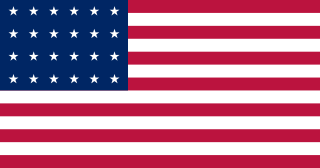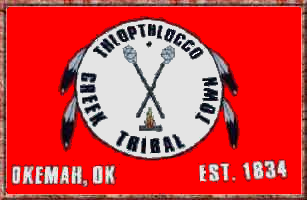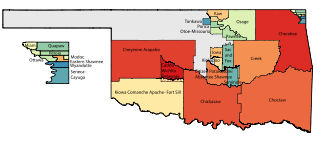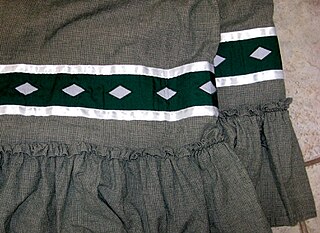
The Indian Reorganization Act (IRA) of June 18, 1934, or the Wheeler–Howard Act, was U.S. federal legislation that dealt with the status of American Indians in the United States. It was the centerpiece of what has been often called the "Indian New Deal". The major goal was to reverse the traditional goal of cultural assimilation of Native Americans into American society and to strengthen, encourage and perpetuate the tribes and their historic Native American cultures in the United States.

The Indian Territory and the Indian Territories are terms that generally described an evolving land area set aside by the United States Government for the relocation of Native Americans who held aboriginal title to their land as a sovereign independent state. In general, the tribes ceded land they occupied in exchange for land grants in 1803. The concept of an Indian Territory was an outcome of the US federal government's 18th- and 19th-century policy of Indian removal. After the American Civil War (1861–1865), the policy of the US government was one of assimilation.

The Peoria are a Native American people. They are enrolled in the federally recognized Peoria Tribe of Indians of Oklahoma, now headquartered in Miami, Oklahoma.

The Oklahoma Indian Welfare Act of 1936 is a United States federal law that extended the 1934 Wheeler-Howard or Indian Reorganization Act to include those tribes within the boundaries of the state of Oklahoma. The purpose of these acts were to rebuild Indian tribal societies, return land to the tribes, enable tribes to rebuild their governments, and emphasize Native culture. These Acts were developed by John Collier, Commissioner of Indian Affairs from 1933 to 1945, who wanted to change federal Indian policy from the "twin evils" of allotment and assimilation, and support Indian self-government.

The Ponca are a Midwestern Native American tribe of the Dhegihan branch of the Siouan language group. There are two federally recognized Ponca tribes: the Ponca Tribe of Nebraska and the Ponca Tribe of Indians of Oklahoma. Their traditions and historical accounts suggest they originated as a tribe east of the Mississippi River in the Ohio River valley area and migrated west for game and as a result of Iroquois wars.

The Quapaw people are a tribe of Native Americans that coalesced in what is known as the Midwest and Ohio Valley of the present-day United States. The Dhegiha Siouan-speaking tribe historically migrated from the Ohio Valley area to the west side of the Mississippi River and resettled in what is now the state of Arkansas; their name for themselves refers to this migration and to traveling downriver.

The Modoc Nation is a federally recognized tribe of Modoc people, located in Ottawa County in the northeast corner of Oklahoma and Modoc and Siskiyou counties in northeast California. The smallest tribe in the state, they are descendants of Captain Jack's band of Modoc people, removed in 1873 after the Modoc Wars from their traditional territory in northern California and southern Oregon. They were exiled to the Quapaw Agency in Indian Territory, where they were colocated with the Shawnee people from east of the Mississippi River.

The Ponca Tribe of Indians of Oklahoma, also known as the Ponca Nation, is one of two federally recognized tribes of Ponca people. The other is the Ponca Tribe of Nebraska. Traditionally, peoples of both tribes have spoken the Omaha-Ponca language, part of the Siouan language family. They share many common cultural norms and characteristics with the Omaha, Osage, Kaw, and Quapaw peoples.
The Quapaw Indian Agency was a territory that included parts of the present-day Oklahoma counties of Ottawa and Delaware. Established in the late 1830s as part of lands allocated to the Cherokee Nation, this area was later leased by the federal government and known as the Leased District. The area that became known as the Quapaw Agency Lands contained 220,000 acres and was located in the northeastern corner of Oklahoma where that state adjoins Missouri and Kansas.

The Muscogee Nation, or Muscogee (Creek) Nation, is a federally recognized Native American tribe based in the U.S. state of Oklahoma. The nation descends from the historic Muscogee Confederacy, a large group of indigenous peoples of the Southeastern Woodlands. Official languages include Muscogee, Yuchi, Natchez, Alabama, and Koasati, with Muscogee retaining the largest number of speakers. They commonly refer to themselves as Este Mvskokvlke. Historically, they were often referred to by European Americans as one of the Five Civilized Tribes of the American Southeast.

Several Native American tribes within the United States register motor vehicles and issue license plates to those vehicles.

Thlopthlocco Tribal Town is both a federally recognized Native American tribe and a traditional township of Muscogee Creek Indians, based in Oklahoma. The tribe's native language is Mvskoke, also called Creek.

The Kialegee Tribal Town is a federally recognized Native American tribe in Oklahoma, as well as a traditional township within the former Muscogee Creek Confederacy in the American Southeast. Tribal members pride themselves on retaining their traditions and many still speak the Muscogee language. The name "Kialegee" comes from the Muscogee word, eka-lache, meaning "head left."

Oklahoma Tribal Statistical Area is a statistical entity identified and delineated by federally recognized American Indian tribes in Oklahoma as part of the U.S. Census Bureau's 2010 Census and ongoing American Community Survey. Many of these areas are also designated Tribal Jurisdictional Areas, areas within which tribes will provide government services and assert other forms of government authority. They differ from standard reservations, such as the Osage Nation of Oklahoma, in that allotment was broken up and as a consequence their residents are a mix of native and non-native people, with only tribal members subject to the tribal government. At least five of these areas, those of the so-called five civilized tribes of Cherokee, Choctaw, Chickasaw, Creek and Seminole, which cover 43% of the area of the state, are formally recognized as reservations by federal treaty, and thus not subject to state law or jurisdiction for tribal members.
On the eve of the American Civil War in 1861, a significant number of Indigenous peoples of the Americas had been relocated from the Southeastern United States to Indian Territory, west of the Mississippi. The inhabitants of the eastern part of the Indian Territory, the Five Civilized Tribes, were suzerain nations with established tribal governments, well established cultures, and legal systems that allowed for slavery. Before European Contact these tribes were generally matriarchial societies, with agriculture being the primary economic pursuit. The bulk of the tribes lived in towns with planned streets, residential and public areas. The people were ruled by complex hereditary chiefdoms of varying size and complexity with high levels of military organization.

Quapaw, or Arkansas, is a Siouan language of the Quapaw people, originally from a region in present-day Arkansas. It is now spoken in Oklahoma.

Ardina Moore was a Quapaw/Osage Native American from Miami, Oklahoma. A fluent Quapaw language speaker, she developed a language preservation program and taught the language to younger tribal members.
Tall Chief was a hereditary chief of the Quapaw Tribe and a peyote roadman. He served in this position after his father, Lame Chief, died in 1874, until his own death in 1918 at around 78 years old.
Victor Griffin was the elected chief of Quapaw Tribe of Indians and a peyote roadman from Quapaw, Oklahoma. Griffin was commonly called either Victor or Vic, and rarely used his first name, William. He conferred with every U.S. president during his term as chief.

Guy Barker is a Quapaw-American politician and attorney serving as the secretary-treasurer of the Quapaw Nation.












